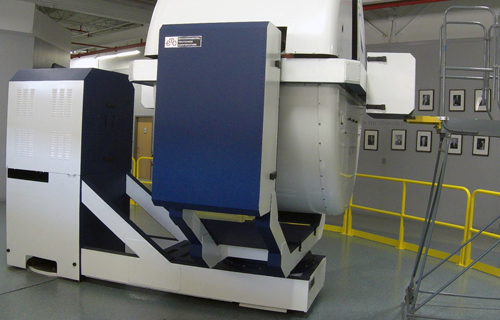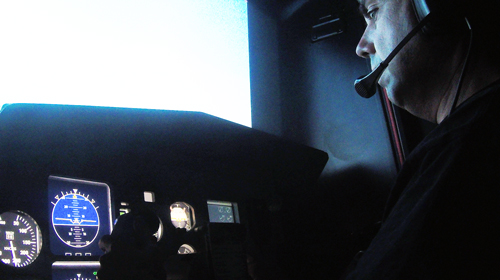Posey's Moonshot
3 Days of Motion Sickness Desensitization: The Worst Part of Spaceflight Training
In his quest to become a commercial astronaut, Brien has been through disaster simulations ranging from oxygen deprivation to emergency water landings. But none of that beats this.
Training to fly on a commercial space mission has been nothing short of a dream come true. The experience has been everything I hoped it would be, and so much more. Even so, there are times when spaceflight training is anything but fun.
Early on, I thought the worst part of training to go to space would be the classroom portion. I was one of those kids who absolutely hated school; when I graduated, I promised myself I was never going back. As luck would have it, however, academics are a huge part of the training process. It's a bit like being in grad school with no end in sight.
But as much as I'm not a fan of the academic portion, the worst part of my quest to become a commercial astronaut had nothing to do with academics. It was motion sickness desensitization training. Thankfully, this part of the training process is not required by the program I have been in for the past several years -- but it was for the program I initially started out in.
Motion sickness desensitization training revolves around a machine called the Gyrolab. The Gyrolab is a full-motion jet aircraft training simulator, which you can see in Figure 1.
 [Click on image for larger view.] Figure 1: The Gyrolab is a full-motion jet aircraft trainer.
[Click on image for larger view.] Figure 1: The Gyrolab is a full-motion jet aircraft trainer.
Prior to my motion sickness training, I logged quite a few hours in the Gyrolab doing spatial disorientation training (but that's another story for another day). You can see me doing a flight in the Gyrolab in Figure 2.
 [Click on image for larger view.] Figure 2: This is the inside of the Gyrolab.
[Click on image for larger view.] Figure 2: This is the inside of the Gyrolab.
Day 1: The Pizza Is a Lie
Unlike the spatial disorientation training, my motion sickness desensitization training did not involve me actually piloting the simulated aircraft myself. Instead, another pilot flew the simulated aircraft from a remote station, and I was simply along for the ride. Suffice it to say that this was no ordinary airplane ride. All of the simulator's out-the-window visuals were disabled to keep me from being able to orient myself. Likewise, all of the aircraft instruments were zeroed-out so I could not use them for reference. My job was to simply sit in the dark while the pilot flew a number of maneuvers that had been carefully choreographed with the goal of inducing motion sickness.
The first day started with a benchmark flight. I was strapped into the simulator and the pilot began flying his routine. Another instructor kept track of how long it took for me to vomit. In case you're wondering, I managed to avoid getting sick for just over seven very long minutes.
Once the instructor achieved an initial benchmark, the pilot was instructed to fly any number of additional choreographed routines. Each of those routines were designed to make me sick, but also to help build my tolerance to motion sickness. Sometimes when I would get sick, I was allowed to take a break for two or three minutes before beginning the next flight. Other times, there was no break in the action.
The motion sickness desensitization training lasted three days. Over the course of those three days, there were two moments that stood out as being particularly bad.
The first of those moments came about three or four hours into the first day. The instructor told me we were going to take a break for lunch. After spending the last few hours getting sick over and over again, lunch was the last thing on my mind. Even though I didn't have much of an appetite, however, I loved the idea of taking a long break.
When I arrived in the break room, I found that someone had ordered pizza. It is apparently a tradition for those who are undergoing motion sickness desensitization training to eat a slice of extremely greasy pizza on the first day of training. I actually thought I would be able to get out of eating it; I'm a vegetarian, and I assumed that a super-greasy pizza would be loaded with meat. Unfortunately, the instructors remembered that I am a vegetarian and ordered cheese pizza. I decided to be a good sport and ate the pizza, even though I really didn't feel like eating. Somehow, I made it through lunch without getting sick, but I wouldn't say it was enjoyable.
Day 2: A No Good, Very Bad Day
The second incident that sticks out in my mind as being especially bad happened at the end of the second day. This incident was way worse than the greasy pizza. Before I tell you what happened, I need to give you a little background information.
At the beginning of this post, I mentioned that someone else would fly the simulated aircraft and that my only job was to go along for the ride. Actually, I had one other job. As the pilot flew the various maneuvers, one of the other instructors asked me to move my head into various positions to induce motion sickness. For example, during the benchmark flight I mentioned earlier, I was asked to move my head in a big circular motion. Remember, I was sitting in the dark with no visual reference and the aircraft was moving in directions known only to the pilot, so the head movements were designed to confuse my neuro-vestibular system.
At the end of the second day, the instructor told me he had some good news for me: I only had one more flight to do that day, and I didn't even have to move my head. The bad news, however, was that the pilot was going to be moving the aircraft in ways that would take the place of head movements.
Before, when I was asked to move my head in various positions, I was the one who was in control. I could make the requested head movements in a slow and controlled manner to minimize my discomfort. In contrast, the pilot's maneuvers were harsh and abrupt. They made me way sicker than anything I had experienced so far.
After reading about these experiences, it might be easy to assume that the instructors were sadistic and got some sort of joy out of torturing me in the simulator. In reality, though, nothing could be further from the truth. The instructors were some of the nicest people I have ever met and they encouraged me every step of the way. Without them, I don't know whether I would have had the mental toughness required to complete the training.
Case in point: When I got out of the simulator at the end of the second day, I was so sick that I could barely walk. The hotel where I was staying was only three miles from the training center, but I knew I was in no condition to make the drive. (I wasn't nearly as sick at the end of the first day, yet it had taken major effort to safely drive myself back to the hotel.) Before I could even say anything, one of the instructors told me he didn't feel good about me driving back to the hotel. Even though it was time for him to go home, he stayed late so I could lie down on a couch at the training center and wait for the worst of the motion sickness to pass.
Eventually, I was able to drive myself back to my room, but the motion sickness was so severe that I still felt nauseous when I woke up the next morning.
Day 3: Daylight
If I am to be completely honest, I seriously considered showing up for the third day of training. I was still sick from the day before and enduring another long day of getting sick over and over again just seemed like something I was physically incapable of getting through.
Even so, I kept reminding myself that if I skipped the training, I would probably never become an astronaut and all the unpleasantness I had endured over the last two days would have been for nothing. As much as I did not want to go through another day of motion sickness desensitization training, I knew that I had to -- that if I didn't complete the program, I would regret it for the rest of my life.
The third day of training was rough, but nowhere near as bad as the second day. Day 3 ended with another benchmark flight -- a repeat of the first flight I did on the Day 1 -- that was designed to demonstrate how my motion tolerance had improved over the course of the three days. Whereas it had initially taken me about seven minutes to become ill, I managed to endure the final benchmark flight for a significantly longer length of time. Unfortunately, I can't remember exactly how long I lasted, but it was somewhere in the neighborhood of 15 minutes.
Motion sickness desensitization training was easily the worst thing I've ever had to go through as a part of my spaceflight training. Even so, I simply cannot imagine how much worse it would have been if the instructors hadn't been so kind and compassionate. To this day I remain grateful because I doubt I would have made it through the training process without them.
About the Author
Brien Posey is a 22-time Microsoft MVP with decades of IT experience. As a freelance writer, Posey has written thousands of articles and contributed to several dozen books on a wide variety of IT topics. Prior to going freelance, Posey was a CIO for a national chain of hospitals and health care facilities. He has also served as a network administrator for some of the country's largest insurance companies and for the Department of Defense at Fort Knox. In addition to his continued work in IT, Posey has spent the last several years actively training as a commercial scientist-astronaut candidate in preparation to fly on a mission to study polar mesospheric clouds from space. You can follow his spaceflight training on his Web site.